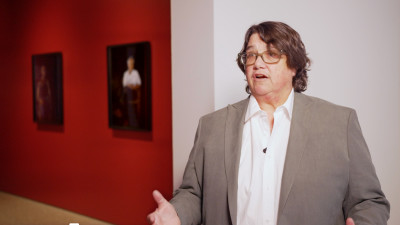Wandering Words
Wandering Words
Artistic responses to 'Sensing Spaces'
By Owen Hopkins
Published 16 April 2014
‘Sensing Spaces’ was a transformative exhibition for the RA in lots of ways and from the beginning we wanted to break new ground in the types of events we organised for it.
-
Events programmes usually tend to run in conjunction with or alongside an exhibition, mainly due to necessity; it is often simply not possible to run events in exhibitions of works that require close inspection, for example. Every so often, however, an exhibition comes along where we have more freedom and can let our imaginations run wild. The recent exhibition, Richard Rogers RA: Inside Out, was certainly one. The final room of the exhibition became home to an ever-growing LEGO city and saw everything from family workshops to Friday evening Soapbox talks, which brought the ethos of Speakers’ Corner to the RA. Many of these ideas have fed into the events programme for Sensing Spaces, some directly, such as the Soapbox, and others more tangentially in terms of new and innovative approaches to engaging the public.
-

Family Studio, 'From the Ground Up'
Photo: Richard Eaton
-
In particular, we wanted the Sensing Spaces events programme to explore architecture’s interactions with the other arts. One of the most interesting – and, arguably, the one that has the longest history – is the interaction between architecture and poetry. From the poets of Ancient Greece and eighteenth-century neoclassical landscapes to the work of T.S. Eliot and the poetry of modern urban decay – architecture and poetry have had a diverse and fertile relationship. So, when we were approached by Emer Gillespie of the group Ekphrasis with the idea of commissioning poets to create new work in response to Sensing Spaces – and then to actually perform these poems in situ – we were intrigued.
-
A film made by students from London Metropolitan University documenting creative responses to Sensing Spaces in two events: Wandering Words (7 March) and Sensing Sounds (10 March)
-
“For a while,” remarks Emer “I have been interested in the idea of asking poets to respond to works of art in a gallery situation.” Working with Ekphrasis collaborators, Abegail Morley and Catherine Smith, Emer “set out to find an exhibition we thought would prove fruitful. Sensing Spaces was just perfect, seven architects working with space; how we live and who we are.” There was no shortage of poets interested in the idea and Emer soon assembled a diverse and eminent group. Meeting several of the poets as they visited the exhibition, it was fascinating to see their initial reactions as they crossed the threshold into the galleries. Several had visited the RA previously and, for them, the experience was perhaps even more powerful, contrasting with the quite different way they had – or perhaps hadn’t – seen the galleries previously.
The philosophy behind Ekphrasis – which literally means “one work of art inspired by another” – has, Emer notes “a long tradition and works particularly well with poetry; it encourages the poet to engage with what he or she sees in way that they find surprising too. I thought this would provide a bridge, not only between the poet and the architect, but for members of the public, stimulating their own unexpected response to what they see and hear.”
-

Installation by Kengo Kuma
Photo © Royal Academy of Arts, London, 2014. Photography: Benedict Johnson. / © Kengo Kuma & Associates
-
The poems were performed in Sensing Spaces over the evening of 7 March. Our galleries are generally open to the public on Friday evenings and for some visitors it may have been a surprise to suddenly come across a poet reading their work amid the general hubbub. But, walking through the galleries over the evening, it was soon apparent that groups of avid listeners were forming around each poet, hanging on their every word before seeking out a poet in the next gallery. The scheduled two hours went so quickly it was with some sadness – but perhaps some relief, as well – that we retired to the bar for a much needed sit down and restorative drink.
Usually when an exhibition closes, little trace is left apart from the memories of all those who visited it. Sensing Spaces has been different. Although created in some ways to be performed in the exhibition, these extraordinary poems stand as a powerful and enduring record. A record not just of a single architectural experience, but, more broadly, of the intriguing capacity for architecture to inspire and entrance, to move and captivate. As Emer concludes, looking back to the evening in early March: “Definitely something to repeat.”
Owen Hopkins is Acting Manager of the RA’s Architecture Programme.





